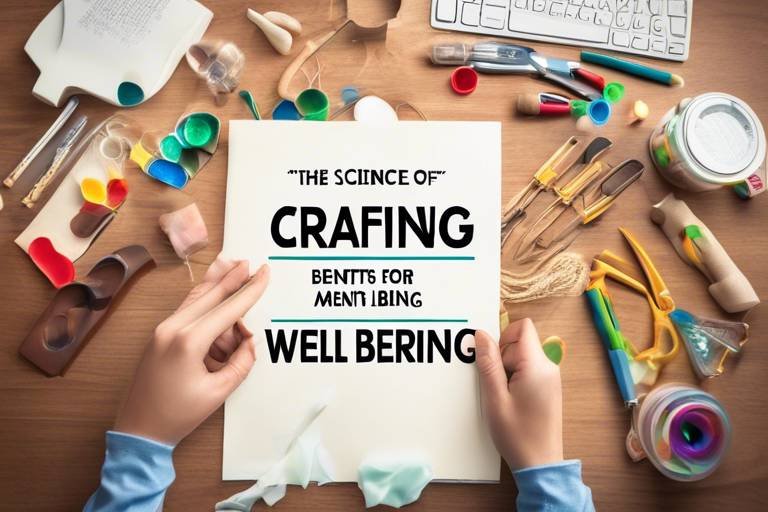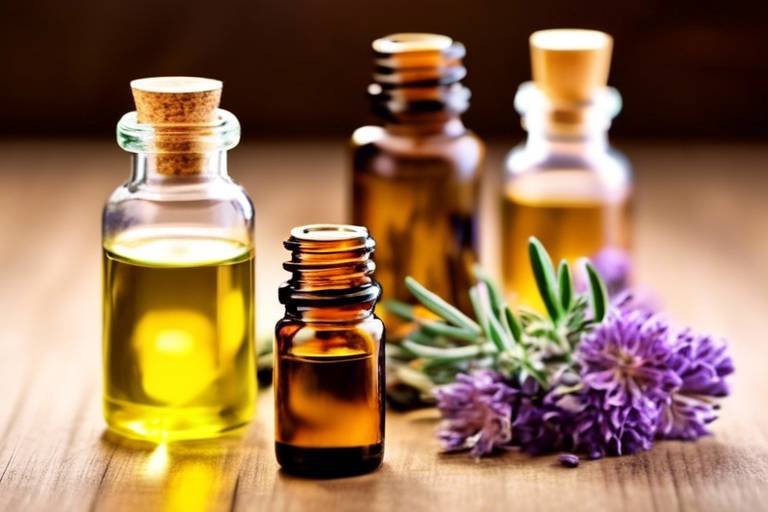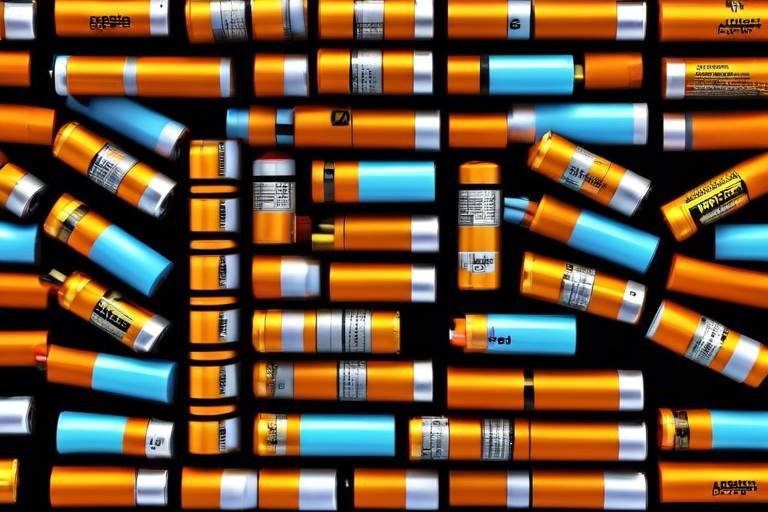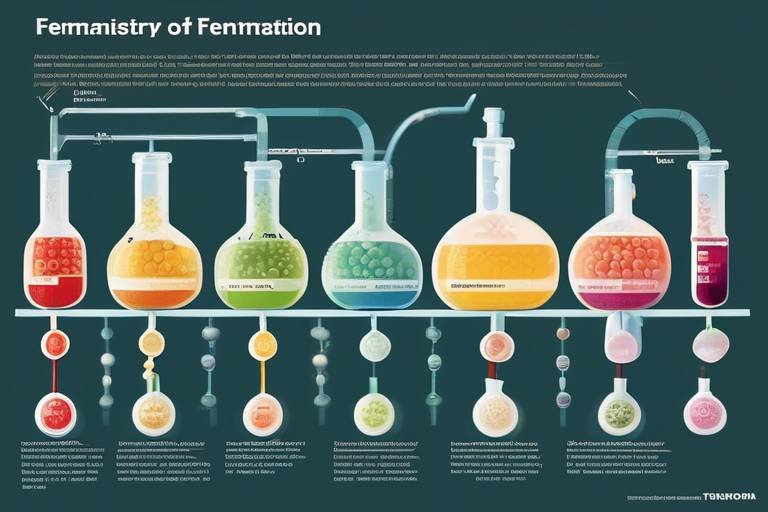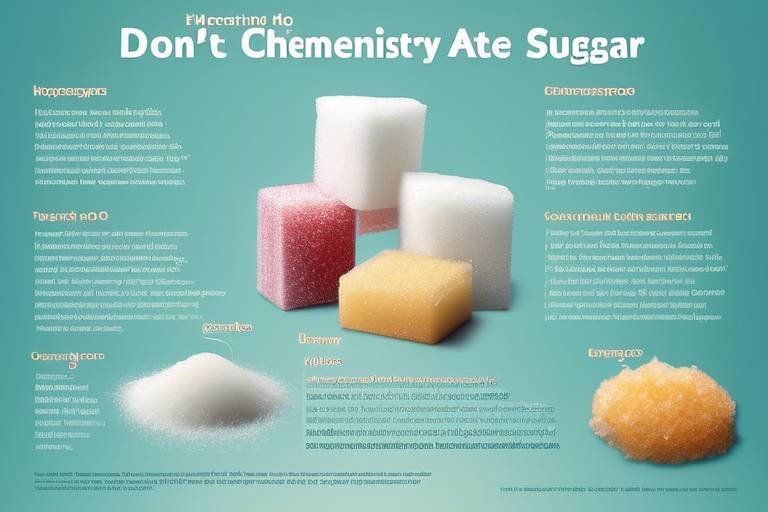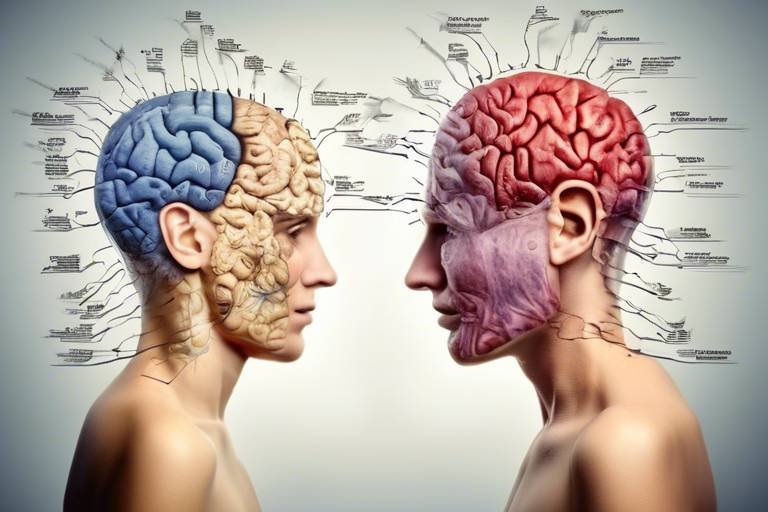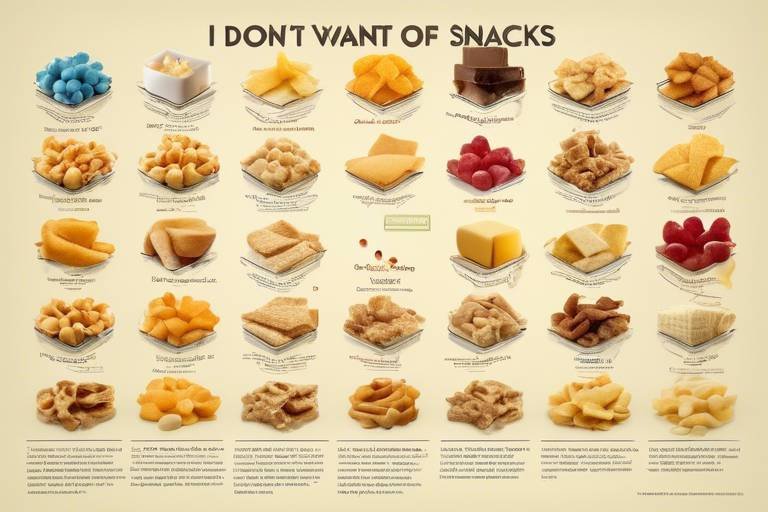The Science of Crafting - Benefits for Mental Well-Being
Have you ever found yourself lost in the rhythm of creating something with your hands? Whether it's knitting a cozy scarf, painting a vibrant canvas, or assembling a model airplane, crafting has this magical ability to transport us to a place of joy and tranquility. This article explores how engaging in crafting activities can enhance mental health, reduce stress, and promote emotional well-being. Discover the psychological benefits and therapeutic aspects of various crafting techniques that not only ignite creativity but also serve as a balm for the mind.
Crafting serves as a form of therapy, providing individuals with a creative outlet to express emotions and alleviate anxiety. It’s like having a personal sanctuary where you can escape the chaos of daily life. In fact, studies have shown that engaging in crafting can lead to significant improvements in mental health. When we create, we not only express ourselves but also foster a sense of accomplishment. Imagine finishing a project after hours of hard work; that feeling of pride can be a powerful antidote to feelings of worthlessness or depression.
Engaging in crafting activities can significantly reduce stress levels. The repetitive motions and focus required in crafting can help calm the mind and promote relaxation. Think of it as a workout for your brain; just as physical exercise releases endorphins, crafting can release those feel-good hormones that help combat stress. When you concentrate on the intricate details of your project, it’s easy to forget about the worries that may be weighing you down.
Crafting encourages mindfulness, allowing individuals to immerse themselves fully in the creative process. This practice of being present in the moment can enhance mental clarity and emotional stability. When you pick up a paintbrush or mold clay, you’re not just creating; you’re engaging all your senses. The texture of the materials, the colors, and even the sounds of your tools can ground you in the present, making it easier to let go of anxieties about the past or future.
Many find crafting to be a meditative practice. Just like traditional meditation, crafting requires focus, patience, and a certain level of detachment from external distractions. The calming effects of both activities can lead to a profound sense of peace. When you lose yourself in the act of creation, it’s as if time stands still, allowing your mind to reset and recharge.
The repetitive actions involved in crafting can induce a trance-like state. This state of flow can help clear the mind and reduce racing thoughts, promoting serenity. It’s similar to how some people find solace in repetitive exercise or even in simple tasks like washing dishes. The act of doing something over and over again can be incredibly soothing.
Crafting provides a unique way to express emotions that may be difficult to articulate verbally. Different crafting mediums can convey feelings and experiences in ways that words often cannot. For instance, a vibrant painting might express joy, while a dark, abstract piece might reflect sadness. This ability to communicate through art can be incredibly therapeutic, allowing individuals to process complex emotions.
Crafting can also foster social connections and community engagement. Group crafting activities can build relationships and provide support networks, enhancing overall mental well-being. Imagine sitting around a table with friends, all working on your individual projects while sharing laughter and stories. This social interaction not only enriches the crafting experience but also creates a sense of belonging.
Participating in crafting groups can lead to lasting friendships. The importance of community in crafting cannot be overstated; it contributes to emotional support and shared experiences. Whether it’s a local knitting circle or an online crafting forum, these communities provide a space where individuals can connect over their shared passion, exchange ideas, and inspire each other.
Working on collaborative crafting projects can strengthen bonds between individuals. Teamwork in crafting fosters a sense of belonging and shared purpose. Think of it as a potluck dinner; everyone brings their unique dish, and together, you create a feast. Similarly, when people come together to craft, they combine their skills and creativity to produce something beautiful and meaningful.
Engaging in crafting can stimulate cognitive functions and enhance problem-solving skills. Various crafting techniques can improve focus, memory, and critical thinking abilities. It’s like a workout for your brain, challenging it to think outside the box and come up with innovative solutions. This mental exercise can be beneficial not only in crafting but also in everyday life.
Crafting activities often require precise hand movements, which can enhance fine motor skills. These skills are crucial for both children and adults, playing a significant role in overall cognitive development. Just like learning to ride a bike, crafting helps refine coordination and dexterity, making it easier to tackle other tasks that require similar skills.
Crafting encourages innovative thinking and creativity. This cognitive benefit can translate into everyday problem-solving and enhance overall mental agility. When you engage in crafting, you learn to approach challenges with a creative mindset, which can be incredibly useful in both personal and professional settings.
- What types of crafting activities are best for mental well-being? Activities like knitting, painting, and pottery are great options as they allow for creativity and focus.
- Can crafting really reduce stress? Yes! The repetitive motions and focus required in crafting can help calm the mind and reduce anxiety.
- How can I get started with crafting? Start with simple projects that interest you, and consider joining a local crafting group for support and inspiration.

The Therapeutic Effects of Crafting
Crafting is more than just a hobby; it's a powerful form of therapy that can profoundly impact mental health. When you engage in crafting, you open up a world where creativity meets emotional expression, allowing you to channel your feelings into something tangible. This creative outlet can be a lifeline for many, particularly during challenging times. Imagine transforming your anxiety into a beautiful piece of art or a handmade item—it's like turning your worries into something that brings joy and satisfaction.
One of the most significant therapeutic effects of crafting is its ability to help individuals express emotions that might be hard to articulate. For instance, when you’re knitting, painting, or even scrapbooking, you might find that your hands are doing the talking. The act of creating can serve as a release, allowing you to process feelings and experiences in a safe and constructive way. This can lead to a sense of accomplishment, boosting your self-esteem and fostering a positive self-image.
Moreover, crafting can serve as a distraction from negative thoughts and stressors. When you immerse yourself in a project, your mind shifts focus, helping to alleviate feelings of anxiety. The repetitive motions involved in many crafting activities can also induce a calming effect, similar to meditation. It’s like giving your brain a mini-vacation! The soothing rhythm of stitching or the gentle strokes of a paintbrush can transport you to a peaceful state, reducing feelings of overwhelm and promoting emotional well-being.
Let’s delve deeper into the psychological benefits of crafting:
- Emotional Release: Crafting allows for the expression of feelings that may be difficult to convey verbally.
- Sense of Accomplishment: Completing a project can provide a significant boost to your self-esteem.
- Distraction from Stress: Engaging in crafting can help divert your mind from negative thoughts.
- Mindfulness Practice: Crafting encourages being present in the moment, enhancing focus and clarity.
In essence, crafting is not just about creating; it's about healing. Whether you're a seasoned crafter or just starting out, the therapeutic effects of crafting can be incredibly beneficial. It’s a unique blend of creativity and mental health support, making it a valuable tool for anyone looking to improve their emotional well-being.
So, the next time you pick up a paintbrush or start knitting, remember that you’re not just making something beautiful; you’re also engaging in a practice that can uplift your spirit and soothe your mind. Crafting is indeed a remarkable journey of self-discovery and healing.

Have you ever felt like the world is spinning too fast, and you just need a moment to breathe? Engaging in crafting activities can be a game-changer when it comes to stress reduction. Crafting isn't just about creating something beautiful; it's also about finding a way to calm your mind and alleviate the pressures of daily life. Think of it as a mini-vacation for your brain, where the only thing you need to focus on is the texture of the materials in your hands and the rhythm of your movements.
When you dive into a crafting project, whether it's knitting a scarf or painting a canvas, the repetitive motions involved can serve as a form of meditation. Much like the gentle waves of the ocean lapping at the shore, these actions can create a soothing rhythm that helps to quiet racing thoughts. This is particularly beneficial for individuals who experience anxiety or stress, as the act of crafting becomes a sanctuary away from the chaos of the outside world.
Moreover, the focus required in crafting can help you enter a state of flow, where time seems to stand still. In this state, you become fully absorbed in the task at hand, allowing your mind to take a break from worries and distractions. This mental shift can lead to feelings of relaxation and contentment, making it easier to tackle life's challenges once you step back into reality.
To illustrate the impact of crafting on stress reduction, consider the following table that compares stress levels before and after engaging in various crafting activities:
| Crafting Activity | Before Crafting (Stress Level 1-10) | After Crafting (Stress Level 1-10) |
|---|---|---|
| Knitting | 7 | 3 |
| Painting | 8 | 4 |
| Scrapbooking | 6 | 2 |
| Puzzle Making | 5 | 2 |
This table demonstrates that regardless of the specific crafting activity, participants generally report a significant decrease in stress levels after engaging in these creative outlets. It's fascinating how something as simple as creating with your hands can have profound effects on your mental state.
In addition to the calming effects of crafting, the satisfaction of completing a project can further enhance your mood. Each finished piece is a tangible reminder of your creativity and effort, providing a sense of accomplishment that can boost your self-esteem. So, the next time you're feeling overwhelmed, consider picking up a craft project. Whether it's a simple DIY home decor item or a complex quilt, the benefits for your mental well-being are undeniable.

When we think about mindfulness, we often picture serene moments of meditation or quiet reflection. However, crafting can serve as a powerful tool for achieving a similar state of mindfulness. Engaging in activities like knitting, painting, or woodworking allows individuals to immerse themselves entirely in the present moment. This immersion is akin to a mental reset, where the chaos of daily life fades away, leaving only the rhythm of your hands and the materials you are working with.
Imagine sitting down with a ball of yarn and a pair of needles. As you begin to knit, your mind shifts focus from the worries of the day to the simple act of creating. Each stitch becomes a meditation, drawing your attention to the tactile sensations and the gentle repetition of the movement. This focus can lead to a state of flow, where time seems to stand still, and the outside world becomes a distant memory.
Crafting encourages you to be present, to truly engage with what you are doing. This is not just about creating something beautiful; it's about the journey of creation itself. Here are some ways crafting can enhance mindfulness:
- Focusing on the Process: Crafting emphasizes the importance of the process rather than the end result. This shift in focus can help reduce anxiety about perfection and allow for a more enjoyable experience.
- Engaging the Senses: The colors, textures, and sounds involved in crafting stimulate the senses, grounding you in the here and now.
- Breathing and Rhythm: The repetitive motions in crafting can help regulate your breath and heart rate, promoting a sense of calm and relaxation.
Moreover, the act of creating something with your own hands can significantly boost your mental clarity. It allows for a moment of reflection, where you can process your thoughts and emotions without distractions. This kind of mindful crafting is not just therapeutic; it can also lead to enhanced emotional stability. By dedicating time to these activities, you cultivate a deeper connection with yourself, which is vital for overall mental health.
In essence, crafting can be a form of active meditation. Just as traditional meditation helps clear the mind and promote peace, crafting can achieve similar outcomes through creativity and expression. Whether you are painting a canvas, assembling a scrapbook, or sculpting clay, you are engaging in a practice that nurtures both your mind and spirit.
So, next time you pick up a crafting project, remember that you are not just making something; you are also giving yourself the gift of mindfulness. This simple act can lead to profound changes in your mental well-being, allowing you to navigate life's challenges with greater ease and clarity.

When we think of meditation, we often picture serene environments, closed eyes, and deep breathing. However, crafting can serve as a powerful form of meditation that many might overlook. Engaging in creative activities like knitting, painting, or woodworking allows individuals to enter a state of flow, where time seems to stand still and worries fade away. This experience is akin to traditional meditation, where the focus shifts inward, promoting a sense of calm and clarity.
Just like meditation, crafting requires us to be present in the moment. As we concentrate on the task at hand—be it molding clay or arranging beads—we become absorbed in the rhythm of the activity. This focused attention can lead to a meditative state, where the mind quiets down, and the chaos of daily life takes a backseat. The repetitive motions involved in crafting can create a soothing rhythm, much like the repetitive chants or mantras used in meditation practices.
Moreover, crafting allows for emotional release. When we immerse ourselves in creative projects, we often find a way to express feelings that might be too complex to articulate verbally. For instance, a painter might channel their feelings of joy or sorrow onto the canvas, providing a therapeutic outlet that promotes emotional healing. This aspect of crafting not only acts as a creative expression but also fosters a deeper understanding of oneself.
To illustrate the similarities between crafting and meditation, consider the following points:
- Focus and Mindfulness: Both activities require concentration and presence, allowing individuals to disconnect from distractions.
- Repetitive Actions: The repetitive nature of certain crafts can induce a trance-like state, similar to breath-focused meditation.
- Emotional Expression: Crafting provides a unique avenue for expressing emotions, akin to the emotional release found in meditation.
- Stress Reduction: Both crafting and meditation can significantly lower stress levels, promoting overall well-being.
In conclusion, crafting is more than just a hobby; it can be a profound form of meditation that nurtures mental health. By allowing ourselves to engage fully in the creative process, we can experience the same benefits that traditional meditation offers, such as enhanced focus, reduced anxiety, and a deeper connection to our emotions. So, the next time you pick up a paintbrush or a skein of yarn, remember that you’re not just creating art—you’re also cultivating a peaceful mind.
Q: Can any craft be used as a form of meditation?
A: Absolutely! Whether it's knitting, painting, or woodworking, any craft that allows you to focus and immerse yourself can serve as a form of meditation.
Q: How does crafting help reduce stress?
A: The repetitive motions and focused attention required in crafting can help calm the mind, similar to the effects of meditation, leading to reduced stress levels.
Q: Do I need to be skilled at crafting to experience these benefits?
A: Not at all! The therapeutic benefits of crafting come from the act of creating itself, not from the skill level. Everyone can find joy and relaxation in the process.
Q: How often should I craft to see mental health benefits?
A: Incorporating crafting into your routine, even for a short period each week, can provide significant mental health benefits. The key is consistency and finding joy in the process.

When it comes to crafting, the repetitive actions involved in many projects can have profound effects on our mental well-being. Think of it like a soothing rhythm, similar to the gentle waves lapping against the shore. These repetitive motions, whether you're knitting, painting, or even cutting paper, create a sense of predictability and control that can be incredibly grounding in our often chaotic lives.
One of the most significant benefits of these repetitive actions is their ability to induce a trance-like state. When you're engaged in a crafting activity, your mind can enter a state of flow, where worries and distractions fade into the background. This state is akin to meditation, allowing for a mental break that can clear racing thoughts and promote a sense of serenity. It's almost like hitting the reset button on your brain, giving you a moment to breathe and recalibrate.
Moreover, the physicality of crafting—whether it’s the rhythmic motion of sewing or the steady strokes of painting—can also trigger the release of endorphins, the body’s natural feel-good chemicals. This not only enhances your mood but also reduces feelings of anxiety and stress. Imagine the satisfaction of completing a repetitive task, like finishing a row of stitches or layering paint on a canvas. This sense of accomplishment can boost your confidence and provide a positive feedback loop that encourages further creativity.
Additionally, engaging in these repetitive activities can foster a sense of mindfulness. As you focus on the task at hand, you become more present in the moment, which can help you appreciate the simple joys of crafting. This mindfulness aspect is crucial, as it helps to anchor your thoughts and emotions, making it easier to navigate the ups and downs of daily life. Just like savoring a delicious meal, the experience becomes richer when you’re fully engaged.
In conclusion, the benefits of repetitive actions in crafting extend beyond just the creative product. They can lead to enhanced mental clarity, emotional stability, and even foster a deeper connection to oneself. So, the next time you pick up your crafting supplies, remember that those simple, repetitive motions are not just about creating; they're about nurturing your mental health.
- What types of crafting are best for stress relief? Activities like knitting, painting, and pottery are often recommended for their repetitive motions and calming effects.
- Can crafting really improve mental health? Yes! Engaging in crafting can reduce anxiety, improve mood, and promote mindfulness.
- How often should I craft to see benefits? Even short, regular sessions can be beneficial. Aim for at least 30 minutes a few times a week.
- Do I need to be skilled at crafting to enjoy its benefits? Not at all! The process is what matters, not the end result. Everyone can find joy in creating.

Crafting is not just about creating something beautiful; it’s a powerful medium for emotional expression. Many individuals find it challenging to articulate their feelings verbally, and this is where crafting steps in as a remarkable alternative. Whether it’s through painting, knitting, or woodworking, each crafting medium offers a unique way to translate complex emotions into tangible forms. Just think about it: when you’re pouring your heart into a piece of art or meticulously assembling a project, you’re not just making something; you’re communicating and processing your feelings.
Consider the act of painting. When you pick up a brush, the colors you choose can reflect your mood. Bright yellows and oranges might signify happiness, while deep blues and blacks could express sadness or introspection. This connection between color and emotion allows crafters to navigate their feelings in a safe space. Similarly, textiles can serve as a canvas for emotions. The repetitive motions of knitting or crocheting can be soothing, allowing the mind to wander while the hands create something meaningful. Each stitch can symbolize a thought, a memory, or a hope, weaving together a narrative that words often fail to capture.
Moreover, different crafting techniques can evoke different emotional responses. For instance,
- Pottery allows for tactile engagement, where shaping clay can be a metaphor for molding one’s life.
- Scrapbooking enables individuals to reflect on cherished memories, creating a visual diary of emotions.
- Collage brings together various elements, symbolizing the complexity of personal experiences.
Crafting also fosters a sense of accomplishment. Completing a project, no matter how small, can instill a feeling of pride and achievement. This boost in self-esteem is crucial for emotional well-being, as it reinforces the idea that you can create and control aspects of your life, even when other areas feel chaotic. In this way, crafting becomes a therapeutic tool, allowing individuals to not only express but also to understand and navigate their emotions.
In essence, crafting is a form of emotional literacy. It teaches us to recognize and articulate our feelings through creative endeavors. So, the next time you pick up a crafting tool, remember that you are not just creating art; you are engaging in a profound dialogue with yourself, using colors, textures, and forms to express what sometimes words cannot.
Q: Can anyone benefit from crafting for emotional expression?
A: Absolutely! Crafting is accessible to everyone, regardless of skill level. It’s about the process, not perfection.
Q: What types of crafting are best for emotional expression?
A: There’s no one-size-fits-all answer. It depends on personal preference! Some may find painting therapeutic, while others might prefer knitting or writing.
Q: How can I start using crafting as a way to express my emotions?
A: Begin with a medium that interests you. Set aside time to create without pressure. Let your emotions guide your choices, and enjoy the process!

Crafting isn't just about creating beautiful objects; it’s also a powerful way to build social connections and foster community. When you engage in crafting, you open the door to shared experiences that can lead to lasting friendships and support networks. Have you ever thought about how those moments spent crafting with others can transform your social life? It’s like unlocking a treasure chest filled with opportunities to connect, collaborate, and communicate.
Many people find that participating in group crafting activities not only enhances their skills but also enriches their lives through the relationships they form. For instance, consider a local knitting circle or a pottery class. These gatherings are not just about the craft itself; they are a chance to share stories, laugh, and support one another. The atmosphere is often warm and inviting, making it easy for even the shyest individuals to feel included. In fact, the social aspect of crafting can significantly boost your mental well-being.
Let's take a closer look at some of the key social benefits of crafting:
- Building Connections: Crafting together creates a sense of camaraderie. Whether you’re working on a quilt or assembling a model, the shared goal fosters connection.
- Emotional Support: Crafting communities often provide emotional support. Sharing personal stories while creating can lead to deeper relationships.
- Skill Sharing: In crafting groups, members often share techniques and tips, enhancing everyone’s skills while building a sense of teamwork.
- Encouragement and Motivation: Being part of a crafting group can motivate you to pursue your projects. Seeing others' progress can inspire you to keep going.
Joining crafting communities can also lead to a sense of belonging. When you’re part of a group that shares your interests, you’re more likely to feel connected and valued. This sense of belonging can be particularly beneficial for those who may struggle with loneliness or social anxiety. The act of creating together can break down barriers, allowing individuals to express themselves freely without fear of judgment.
Moreover, collaborative crafting projects can strengthen bonds between individuals. Imagine working on a community mural or a large-scale art installation; these projects require teamwork and communication, which can enhance relationships. Through collaboration, participants learn to appreciate each other's strengths and creativity, fostering a sense of shared purpose and achievement.
In summary, the social benefits of crafting extend far beyond the items we create. They encompass emotional support, skill development, and the formation of meaningful relationships. So, the next time you pick up those knitting needles or paintbrushes, remember that you’re not just crafting; you’re also weaving the fabric of community and connection.
- What types of crafting activities are best for socializing? Activities like knitting circles, pottery classes, and scrapbooking groups are excellent for social interaction.
- How can I find a local crafting community? Check local community centers, craft stores, or online platforms like Meetup to find groups near you.
- Can crafting help with social anxiety? Yes, engaging in group crafting can provide a supportive environment that makes socializing easier.

Joining crafting communities can be a transformative experience, offering not just a chance to improve your skills but also an opportunity to connect with like-minded individuals. Imagine walking into a room filled with people who share your passion for crafting—it's electric! The energy, the creativity, and the camaraderie can be incredibly uplifting. These communities can take many forms, from local craft clubs to online forums, and each has its unique vibe and benefits.
When you engage with a crafting community, you open yourself up to a world of inspiration and support. You'll find that sharing your projects and ideas with others can lead to constructive feedback and encouragement. Plus, you'll likely discover new techniques and styles that you may not have considered before. This exchange of ideas can spark your creativity, pushing you to explore new avenues in your crafting journey.
One of the most significant advantages of joining a crafting community is the emotional support it provides. Crafting can sometimes be a solitary activity, which can lead to feelings of isolation. However, being part of a community can alleviate this by fostering friendships and connections. You’ll find that many members are eager to share their experiences, struggles, and triumphs, creating a safe space for everyone to express themselves. This sense of belonging is crucial for mental well-being, as it reinforces the idea that you are not alone in your crafting endeavors.
Furthermore, collaborative crafting projects can take these connections to the next level. Working together on a shared project not only strengthens bonds but also enhances the overall crafting experience. It allows individuals to combine their unique skills and ideas, resulting in something truly special. Whether it’s a community quilt, a mural, or a charity project, the sense of achievement that comes from collaborating can be immensely fulfilling.
To illustrate the impact of crafting communities, consider the following benefits:
- Skill Development: Learn new techniques and improve existing skills through shared knowledge.
- Emotional Support: Build meaningful relationships that provide encouragement and understanding.
- Inspiration: Discover fresh ideas and perspectives that can reignite your passion for crafting.
- Collaboration: Engage in group projects that foster teamwork and creativity.
In conclusion, joining a crafting community can significantly enrich your crafting experience. You'll not only enhance your skills but also forge lasting friendships and gain emotional support. So, whether you’re looking to learn, share, or simply enjoy the company of fellow crafters, diving into a crafting community could be one of the best decisions you make for your mental well-being.
Q: How do I find a crafting community near me?
A: You can start by checking local community centers, libraries, or craft stores for workshops or clubs. Online platforms like Facebook or Meetup also have groups dedicated to various crafting interests.
Q: What if I'm not experienced in crafting?
A: No worries! Crafting communities are often welcoming to all skill levels. Many members are eager to help beginners learn and grow.
Q: Are online crafting communities just as beneficial as in-person ones?
A: Absolutely! Online communities can provide a wealth of resources, support, and inspiration, making them a great option for those who may not have local groups available.
Q: Can I start my own crafting community?
A: Yes! If you have a passion for crafting and want to share it with others, consider starting your own group. You can use social media, local bulletin boards, or community centers to gather interested crafters.

When it comes to crafting, the magic often happens when we come together with others to create something unique. Collaborative crafting projects not only allow us to pool our resources and skills but also enhance our social interactions and emotional connections. Imagine a group of friends gathered around a table, each with their own supplies, sharing ideas, laughter, and stories as they work on their individual pieces or a collective masterpiece. This dynamic fosters a sense of community that is hard to replicate when crafting alone.
One of the most significant benefits of collaborative crafting is the opportunity for teamwork. Just like in a well-coordinated dance, each participant has a role to play, whether it's cutting, gluing, or painting. This shared experience not only strengthens relationships but also helps individuals feel valued and appreciated for their contributions. In fact, studies have shown that working together on creative projects can improve overall mental well-being, as it provides a sense of purpose and belonging.
Additionally, collaborative projects often lead to a diversity of ideas. When people from different backgrounds and skill levels come together, they bring unique perspectives that can enhance the creative process. For instance, one person might suggest an unexpected color combination, while another might introduce a technique they've learned from a different crafting medium. This exchange can spark inspiration and innovation, pushing everyone involved to think outside the box.
Moreover, collaborative crafting can serve as a support system. Whether it’s a community art project or a simple gathering of friends, crafting together allows individuals to share their struggles and triumphs, creating a safe space for emotional expression. Participants can offer encouragement and feedback, helping each other navigate challenges and celebrate successes. This camaraderie not only makes the crafting experience more enjoyable but also reinforces the notion that we are not alone in our journeys.
To illustrate the impact of collaborative crafting, consider a community mural project where each participant contributes a panel that reflects their personal story. As these individual pieces come together, they create a vibrant tapestry that tells a collective tale, showcasing the beauty of diversity and unity. Such projects not only beautify public spaces but also engage the community, fostering a sense of pride and ownership.
In conclusion, engaging in collaborative crafting projects is a fantastic way to enhance social connections, spark creativity, and promote mental well-being. Whether you're working on a large community project or simply crafting with friends, the benefits of collaboration are immense. So, gather your supplies, invite some friends over, and let the magic of crafting together transform your experience into something truly special!
- What types of projects are best for collaborative crafting? Collaborative crafting can range from simple projects like making greeting cards to larger endeavors like community murals or quilt-making. The key is to choose something that allows everyone to contribute their unique touch.
- How can I find a crafting group in my area? Look for local craft stores, community centers, or online platforms like Meetup to find groups that share your crafting interests. Many libraries also host crafting events.
- What if I’m not very skilled at crafting? Don’t worry! Collaborative crafting is about enjoying the process and learning from others. Everyone starts somewhere, and the supportive environment will help you improve your skills over time.
- Can collaborative crafting help with mental health? Absolutely! Working with others can provide emotional support, reduce feelings of isolation, and enhance your overall sense of well-being.

Engaging in crafting activities isn't just about creating beautiful objects; it also serves as a powerful tool for enhancing cognitive development. When you immerse yourself in crafting, you're not only tapping into your creative side but also stimulating various cognitive functions that are crucial for problem-solving and critical thinking. Think of crafting as a workout for your brain—each stitch, cut, or brush stroke is like a rep that builds your mental muscles.
One of the most significant benefits of crafting is its ability to improve focus and concentration. As you navigate through the steps of a project, whether it’s knitting a scarf or building a model, your brain is actively engaged in planning and executing tasks. This level of engagement helps to sharpen your attention span, making it easier to concentrate on other aspects of your life. In fact, studies have shown that individuals who engage in regular crafting activities often report better focus and improved memory retention.
Moreover, crafting can enhance your problem-solving skills. When faced with challenges during a project—like figuring out how to assemble a complex piece of furniture or choosing the right colors for a painting—you’re forced to think critically and adapt your approach. This not only boosts your creativity but also encourages innovative thinking. Crafting can serve as a safe space to experiment and make mistakes, which is essential for cognitive growth. The next time you find yourself stuck on a project, consider it an opportunity to flex your mental muscles!
Additionally, the fine motor skills developed through crafting activities play a crucial role in cognitive development. These skills involve the coordination of small muscles in the hands and fingers, which are essential for tasks such as writing, typing, and even everyday activities like buttoning a shirt. The more you engage in crafting, the more you refine these skills. Here’s a quick overview of how crafting enhances fine motor skills:
| Crafting Activity | Fine Motor Skills Developed |
|---|---|
| Knitting | Hand-eye coordination, dexterity |
| Painting | Control of brush movements, grip strength |
| Origami | Precision in folding, spatial awareness |
| Sewing | Pinching, threading, and stitching techniques |
Crafting is not just an enjoyable pastime; it’s an enriching experience that fosters cognitive development in numerous ways. Whether you are a seasoned crafter or just starting out, remember that every project you undertake is an opportunity to enhance your mental agility and problem-solving capabilities. So, gather your materials and let your creativity flow—your brain will thank you!
- What types of crafting are best for cognitive development? Activities such as knitting, painting, and woodworking are excellent choices as they require focus, precision, and creativity.
- Can crafting help with anxiety and stress? Yes! Engaging in crafting can serve as a form of therapy, helping to reduce anxiety and promote relaxation.
- How often should I craft to see cognitive benefits? Regular engagement, even just a few times a week, can significantly enhance cognitive functions over time.

Engaging in crafting activities is not just about creating beautiful pieces of art; it also plays a crucial role in developing fine motor skills. These skills involve the use of small muscles in our hands and fingers, which are essential for tasks like writing, buttoning shirts, and even typing. When you dive into crafting, whether it’s knitting, sewing, or even intricate paper crafts, you are essentially giving your brain and body a workout. The precise movements required in these activities help to strengthen the connections between your brain and your hands, enhancing coordination and dexterity.
Think about it: when you’re cutting shapes out of paper, your fingers are working in harmony to control the scissors. Each snip and cut requires focus and precision, which in turn boosts your hand-eye coordination. This is especially beneficial for children, as their developing brains are like sponges, soaking up new skills. However, it’s not just kids who benefit; adults can also see improvements in their fine motor skills through consistent crafting. For instance, a study published in the Journal of Occupational Therapy found that older adults who engaged in crafting activities showed significant improvement in their manual dexterity and hand strength.
It's fascinating how different crafting mediums can target various aspects of fine motor skill development. Here’s a quick breakdown of how some popular crafting activities contribute to these skills:
| Crafting Activity | Fine Motor Skill Benefits |
|---|---|
| Knitting | Enhances finger dexterity and coordination through repetitive movements. |
| Painting | Improves control over brush strokes, aiding in precision. |
| Origami | Develops spatial awareness and finger strength through intricate folds. |
| Sewing | Requires precise hand movements and coordination, enhancing grip strength. |
As you can see, each crafting method offers unique benefits that contribute to the development of fine motor skills. The beauty of crafting lies in its ability to engage both the mind and body, creating a holistic approach to skill enhancement. So, the next time you pick up a craft project, remember that you’re not just expressing your creativity; you’re also giving your fine motor skills a much-needed boost!
In addition to improving dexterity, crafting also fosters patience and perseverance. As you work on a project, you learn to navigate challenges and refine your skills, which can be incredibly rewarding. This sense of accomplishment can lead to increased confidence, encouraging you to tackle more complex projects in the future. Ultimately, crafting is a multifaceted activity that not only enriches your life aesthetically but also enhances your cognitive and physical abilities in profound ways.
- What types of crafts are best for developing fine motor skills?
Activities like knitting, sewing, painting, and origami are particularly effective as they require precise hand movements.
- Can adults benefit from crafting?
Absolutely! Adults can see significant improvements in their fine motor skills, hand strength, and overall cognitive function through regular crafting activities.
- How often should I engage in crafting to see improvements?
Regular practice, even as little as 30 minutes a week, can lead to noticeable improvements over time.
- Is crafting a good way to relieve stress?
Yes! The repetitive motions and focus required in crafting can help calm the mind and promote relaxation.

Crafting is not just a hobby; it’s a powerful catalyst for creativity and innovation. When you engage in crafting, you’re not merely following instructions; you’re diving into a world where your imagination can run wild. Think of crafting as a playground for your mind—each material you use is a tool that can unlock new ideas and solutions. It’s fascinating how something as simple as a piece of paper or a ball of yarn can inspire a whirlwind of creativity!
One of the most exciting aspects of crafting is that it encourages you to think outside the box. When faced with a project, you might find yourself experimenting with different techniques or materials that you’ve never tried before. This exploration not only leads to unique creations but also fosters a mindset of innovation. You start to see challenges as opportunities to create something new, which can be incredibly empowering.
Moreover, crafting can enhance your problem-solving skills. For instance, when you’re working on a complex project, you may encounter hurdles that require you to come up with creative solutions. This process of troubleshooting and adapting is akin to a mental workout, strengthening your cognitive abilities. Here’s how crafting can enhance your creativity:
- Experimentation: Trying out new techniques or materials can lead to unexpected results, sparking further ideas.
- Critical Thinking: Deciding how to approach a project involves planning and strategizing, which sharpens your analytical skills.
- Emotional Expression: Crafting allows you to express feelings that might be hard to articulate, leading to deeper insights about yourself.
In addition, the tactile nature of crafting—feeling the textures, manipulating the materials—can stimulate your senses and open your mind to new possibilities. It’s as if each stitch, cut, or brushstroke is a step down a path of discovery. This sensory engagement can also trigger memories and emotions, further fueling your creative process.
Ultimately, the act of creating something from nothing is profoundly satisfying. It’s like being an alchemist, turning simple materials into treasures that reflect your personality and perspective. This sense of accomplishment can boost your confidence, encouraging you to tackle even more ambitious projects in the future. So, whether you’re knitting a scarf, painting a canvas, or building a model, remember that you’re not just crafting; you’re innovating!
In summary, crafting is a multifaceted activity that nurtures creativity and fosters innovation. Through experimentation, critical thinking, and sensory engagement, you can enhance your cognitive functions and develop a more creative mindset. So, grab those supplies and let your imagination soar!
- What types of crafting are best for enhancing creativity? Any form of crafting can boost creativity, but activities like painting, sculpting, or mixed media often allow for more freedom of expression.
- How often should I craft to see benefits? Even short, regular sessions can be beneficial. Aim for at least a few times a week to keep your creative juices flowing.
- Can crafting help with anxiety? Yes, many people find that crafting provides a calming effect and can help alleviate anxiety through focused, mindful engagement.
Frequently Asked Questions
- What are the mental health benefits of crafting?
Engaging in crafting activities can significantly enhance mental well-being. It serves as a creative outlet that helps reduce stress, alleviate anxiety, and foster a sense of accomplishment. Crafting allows individuals to express emotions that might be hard to articulate, making it a valuable tool for emotional health.
- How does crafting help with stress reduction?
The repetitive motions involved in crafting, such as knitting or painting, can induce a calming effect on the mind. This focus on the task at hand helps to distract from daily stressors, promoting relaxation and mindfulness. It's like a mini-vacation for your brain!
- Can crafting be considered a form of meditation?
Absolutely! Many people find that crafting shares similarities with meditation. Both activities encourage a state of flow where individuals can immerse themselves fully in the moment, leading to mental clarity and emotional stability. It’s a wonderful way to achieve a meditative state without sitting still!
- How can crafting enhance social connections?
Joining crafting groups or communities can create lasting friendships and support networks. The collaborative nature of crafting projects encourages teamwork, which fosters a sense of belonging and shared purpose among participants. It’s a fun way to meet like-minded individuals!
- What cognitive skills can be developed through crafting?
Crafting stimulates various cognitive functions, including problem-solving, focus, and memory. The precision required in crafting activities enhances fine motor skills, which are essential for both children and adults. Plus, it encourages innovative thinking, making everyday problem-solving easier!
- Is there a specific type of crafting that is best for mental health?
There isn't a one-size-fits-all answer! Different types of crafting can offer unique benefits. Whether you enjoy painting, knitting, or woodworking, the key is to find an activity that resonates with you personally. The best crafting is the one that brings you joy and relaxation!
- How often should I engage in crafting to see benefits?
Even short, regular crafting sessions can yield positive effects on mental health. Aim for at least a few times a week, but remember, it’s all about what fits into your schedule. Consistency is key, but don’t stress—enjoy the process!

